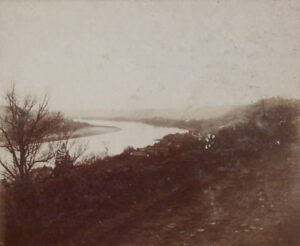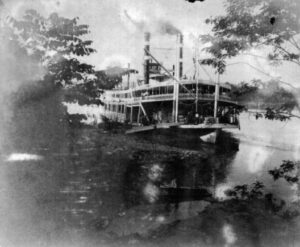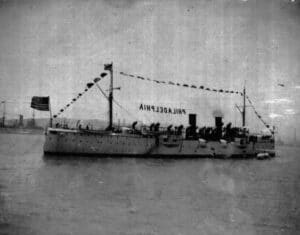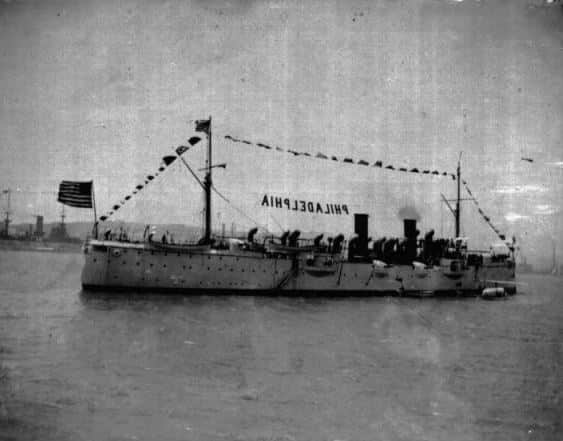Earl Brooks’ Photog raphs: Boats and Travel
raphs: Boats and Travel
By: David Heighway, Hamilton County Historian
Continuing our look at Earl Brooks and the photographs he took as a young man, I thought I might point out some images that are not of Hamilton County. These would have been taken on trips with his family and show what scenes and objects would have caught his eye.
His album has many images of trips to Maysville, Kentucky, on the Ohio River. There is also a shot captioned “Mississippi River at New Orleans”. Trips like this would have given him many opportunities to see the steamboats on the river which people found just as interesting then as they do today. Information about these boats can be found in the standard reference texts for steamboats – Way’s Packet Directory, 1848-1983 and Way’s Steam Towboat Directory by Frederick Way.
There are two steamboat images in the Brooks collection which are captioned “City of Pittsburg” and can be seen here and here. The City of Pittsburg was built in Ohio in 1899 and was 292 feet long, 79.5 feet wide, and was powered by three boilers. At first, she ran between Pittsburg and Louisville, then she switched to the Cincinnati to Memphis route. She burned on April 20, 1902, near Cairo, Illinois, with severe loss of life – 60 to 75 people.
 Another steamboat image is captioned “Indiana”. The sidewheel steamboat Indiana was built by the Howard Boatyards in Jeffersonville in 1900 and was 285 feet long, 45 feet wide, and was very shallow draft. She ran between Louisville and Cincinnati, substituting for other boats at low water times. She partially burned in May of 1916 and was rebuilt and renamed.
Another steamboat image is captioned “Indiana”. The sidewheel steamboat Indiana was built by the Howard Boatyards in Jeffersonville in 1900 and was 285 feet long, 45 feet wide, and was very shallow draft. She ran between Louisville and Cincinnati, substituting for other boats at low water times. She partially burned in May of 1916 and was rebuilt and renamed.
A hard-to-see image is captioned “Enterprise”. This was a sternwheel towboat which moved barges of freight up and down the river, (even though the riverboats pushed rather than pulled, they are still called “towboats”). This boat has two possible histories: It was either built in Pittsburg in 1873 and disassembled in Elizabeth, Pennsylvania, in 1902, or, it was built in Elizabeth in 1903 and eventually moved to Mexico where it sunk in 1921.
At some point, probably after 1902, Brooks and his family took a trip to the Pacific coast and saw the states of California, Oregon, and Washington. The ships that he saw there were much different than the steamboats on the inland rivers.
One image is captioned “On the ferry boat crossing the Columbia River”. This was the steel-built Kalama (later renamed Tacoma). According to Wikipedia, it “transported trains between Kalama, Washington and Goble, Oregon. This train ferry was shipped in more than 50,000 parts around Cape Horn and assembled in Portland. This Northern Pacific Railroad ferry was 338 feet (103 m) long and 42 feet (13 m) wide and continued in use from 1883 until around 1910 when a railroad bridge across the river was built.” (Corning, Howard M.: Dictionary of Oregon History. Binfords & Mort Publishing, 1956.) The Northern Pacific Railroad logo can be seen on the engine in the photograph.
 Another image is captioned “U.S. Gun Boat”, even though the name can be seen (reversed) on a banner between the two masts. The USS Philadelphia was launched in 1889 and was designated the flagship of the Admiral of the North Atlantic Squadron. In 1893, it moved to Hawaii and was designated the flagship of the Commander-in-Chief of the Pacific Station. In 1902, needing repairs, it was sailed to Puget Sound and decommissioned on September 22. This is probably where Earl Brooks saw it. It served as a receiving ship and prison ship until it was struck from the Navy list in 1926.
Another image is captioned “U.S. Gun Boat”, even though the name can be seen (reversed) on a banner between the two masts. The USS Philadelphia was launched in 1889 and was designated the flagship of the Admiral of the North Atlantic Squadron. In 1893, it moved to Hawaii and was designated the flagship of the Commander-in-Chief of the Pacific Station. In 1902, needing repairs, it was sailed to Puget Sound and decommissioned on September 22. This is probably where Earl Brooks saw it. It served as a receiving ship and prison ship until it was struck from the Navy list in 1926.
A last image is captioned “Training ship Adams – Pacific coast”. The USS Adams was launched in 1874 and was possibly the last sailing ship to see active duty in the US Navy. Brooks probably saw it sometime between 1899 and 1904, when it was a training ship that cruised along the west coast of the US. It was turned over to the state of Pennsylvania in August 1908 to be used by the Public Marine School in Philadelphia. It was returned to the Navy in 1914 for training and for use during WWI. It was decommissioned in 1919 and broken up in 1921 or 1922.
